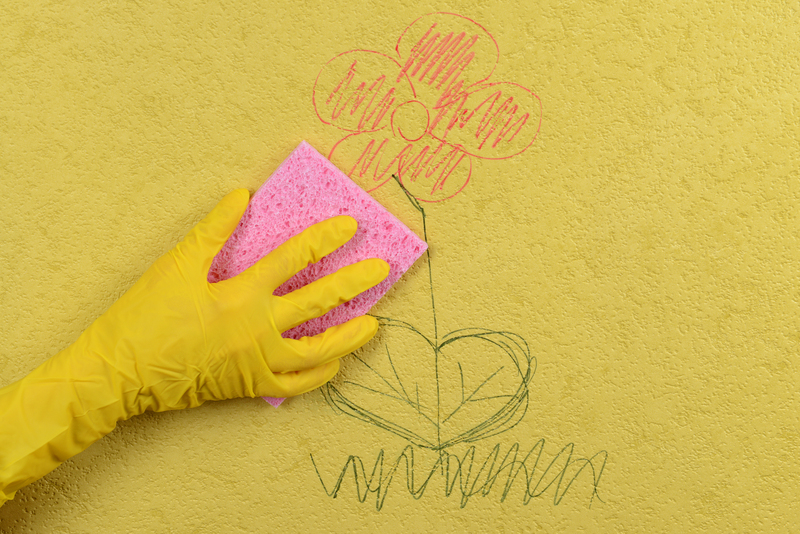The Science Behind Steam Cleaning Your Leather Sofa
Posted on 18/05/2025
The Science Behind Steam Cleaning Your Leather Sofa
When it comes to maintaining the luxury and longevity of your furnishings, leather sofas stand out for their durability and elegant looks. However, cleaning these sophisticated pieces requires more than just a wipe down with a wet cloth. That's where steam cleaning leather sofas enters the conversation as a modern, effective, and chemical-free pathway to a refreshed sofa. But what exactly happens during steam cleaning? Why is it an effective method? And, most importantly, is it safe for your precious leather? Let's dive deep into the science behind steam cleaning your leather sofa.
Understanding Leather and Its Unique Cleaning Needs
Leather is much more than just animal hide; it's a complex, natural material with a unique cellular structure. This structure sets leather apart from fabric, making it both durable and susceptible to certain types of damage if cleaned improperly. Understanding the intricacies of leather is essential before employing any cleaning method, especially one as powerful as steam cleaning.
The Structure of Leather
- Porous Nature: Leather contains millions of microscopic pores that help it "breathe." These pores can trap dirt, dust, oils, and other debris.
- Protein Fibers: Made up of tightly interwoven protein fibers, leather is strong but can dry out or crack if exposed to harsh elements.
- Natural Oils: Leather maintains its suppleness from natural and added oils, which are essential for keeping it soft and flexible.
Because of these features, regular cleaning methods may not penetrate deep enough or might even cause more harm than good. This calls for modern solutions like steam cleaning your leather settee.

What is Steam Cleaning and How Does it Work?
The Basics: Steam Technology
Steam cleaning is a technique that uses high-temperature steam to loosen dirt, kill germs, and refresh surfaces. The science is simple yet powerful: water is heated past its boiling point to create pressurized steam, which is then directed onto the surface via a nozzle.
- Heat: The high temperature of the steam (often between 100?C to 150?C or more) acts as a natural disinfectant.
- Moisture: The vapor's small water molecules penetrate deep into the pores, loosening debris without drenching the material.
- Pressure: The force of the steam helps dislodge trapped dirt and grime, making it easier to wipe away.
But how does all this apply when you steam clean a leather sofa?
How Steam Cleaning Interacts With Leather
Pore Deep Cleaning
Leather's porous nature means dirt and bacteria can easily settle below the surface. Traditional cleaning methods often fail to reach these inner layers. Steam cleaning sends vapor molecules deep into the pores, agitating and loosening grime that has seeped into the material.
Natural Disinfection Without Chemicals
Bacteria, dust mites, and allergens can thrive within your beloved leather couch. The high heat of steam effectively destroys these microorganisms on contact--without resorting to harsh chemical sprays or soaps that can damage or discolor leather.
Safe Moisture Control
Despite being a moisture-based method, steam cleaning delivers minimal moisture--the vapor quickly evaporates from the leather surface. This reduces the risk of water stains, swelling, or mildew, which can be a concern with soaking or improper cleaning.
Benefits of Steam Cleaning Your Leather Sofa
- Deep Sanitization: Steam kills up to 99.9% of bacteria, viruses, and dust mites lurking in the leather without harsh chemicals.
- Allergen Removal: If you suffer from allergies, cleaning with steam can remove allergens better than dry dusting or vacuuming alone.
- Revives Leather Appearance: Steam cleaning gently lifts oils and embedded dirt, restoring the leather's natural luster and color.
- Eco-Friendly and Safe: No need for cleaning chemicals or synthetic solutions--just pure water turned into steam.
- Odor Removal: Steam effectively neutralizes musty or unpleasant odors that may be trapped by the leather.
Is Steam Cleaning Safe for All Types of Leather?
Before using a steam cleaner on your leather sofa, it's crucial to assess the type of leather you own. Not all leather is created equal, and steam cleaning may not be suitable for every variety.
Types of Leather and Their Steam Compatibility
- Protected (Finished) Leather: The most common in sofas, finished with a protective coating. Generally safe for gentle steam cleaning.
- Unprotected (Aniline) Leather: Soft, natural, and more absorbent. Not recommended for regular steam cleaning as it can absorb too much moisture.
- Nubuck/Suede: Highly absorbent, delicate surface. Do not use steam cleaning; it can ruin the texture.
- Bonded Leather: Made from leather scraps and mixed with other materials; may respond unpredictably to steam.
Always test a small, inconspicuous area before proceeding with a full-fledged steam clean on your leather sofa.
Step-by-Step: How to Steam Clean Your Leather Sofa Safely
Ready to try steam cleaning your leather sofa at home? Follow these science-backed steps to achieve a sparkling result without risk.
1. Prepare Your Sofa
- Remove cushions and any throws or decorative pillows.
- Vacuum the surface and crevices with a soft brush attachment to remove dust and loose particles.
- Wipe the sofa with a dry microfiber cloth.
2. Select the Right Steam Cleaner
- Choose a steam cleaner with adjustable temperature and pressure settings. Lower settings are better for delicate or fine leather.
- Use only distilled water to prevent mineral deposits or residue.
- Attach a microfiber cloth to the steam head to further diffuse the steam and prevent direct contact.
3. Perform a Patch Test
- Steam a small hidden area to ensure the leather tolerates the heat and moisture without discoloration or damage.
4. Steam Clean Carefully
- Hold the steam cleaner a few inches away from the surface or pass it over gently, never letting it sit in one spot.
- Work in small sections, immediately wiping away loosened dirt and moisture with a clean microfiber cloth.
- Avoid over-wetting the leather. Too much steam or contact time can cause damage.
5. Condition Your Leather
- Once the sofa is fully clean and dry, apply a high-quality leather conditioner. This restores the natural oils and keeps the leather supple.
Common Mistakes to Avoid When Steam Cleaning Leather
- Direct Contact with Nozzle: Never let the nozzle touch the leather directly; always use a cloth or upholstery attachment.
- Too Much Heat or Pressure: Excessive force can crack or warp the leather's surface.
- Skipping Patch Test: Always test first; some dyes or finishes may react with heat.
- Forgetting to Condition: Steam can strip away essential moisture--restoration is key.
- Ignoring Stains: Deep stains might need pre-treatment with a leather-safe cleaner before steam cleaning.
The Science-Backed Results: Why Does Steam Cleaning Work So Well?
Let's recap the science:
- Heat Denatures Proteins and Kills Germs: The high temperatures from steam disrupt the cell membranes of bacteria and deactivate viruses and fungi. This effectively sterilizes the surface.
- Steam Penetrates Pores: The tiny vapor molecules dislodge embedded dirt in a way that traditional cleaning chemicals cannot.
- Rapid Evaporation: Unlike water, steam doesn't flood the leather but instead evaporates quickly, minimizing the risk of water damage.
Thanks to these factors, steam cleaning your leather couch can leave your upholstery looking and feeling as if it just came fresh from the showroom, provided it's done carefully.
When To Call a Professional
While DIY steam cleaning your leather sofa is possible, it's not always the safest choice, especially with delicate, antique, or high-end leather. You should consider hiring a certified professional if:
- Your sofa is made from aniline, nubuck, or other unfinished leather types
- There are deep stains, mold, or strong odors
- It's a valuable or irreplaceable piece of furniture
- You're unsure about the cleaning process
Tips for Maintaining Leather Sofas After Steam Cleaning
- Regular Conditioning: Use a leather conditioner every 3-6 months.
- Avoid Direct Sunlight: UV rays can fade and dry out the leather.
- Handle Spills Fast: Blot (don't rub) any spills to prevent stains or water marks.
- Periodic Dusting: Keep your sofa free from surface dust, oils, and pet hair.

Frequently Asked Questions on Steam Cleaning Leather Sofas
Is it really better than traditional cleaning?
Yes--steam cleaning leather is both more hygienic and better at deep cleaning without damaging the material, thanks to the penetration power of vapor and its ability to kill germs naturally.
Can you use a handheld steam cleaner on leather?
Handheld steamers are suitable, but they must have a controlled setting for temperature and pressure to avoid damaging delicate leather finishes.
How often should you steam clean your leather sofa?
Experts recommend steam cleaning no more than twice a year for regular maintenance. Over-cleaning can dry out the leather.
Does steam cleaning remove all stains?
Steam is effective on many types of dirt and some stains, but oil-based or dye-based stains might need specialized cleaning products.
Conclusion: The Smart, Science-Based Approach to Leather Sofa Cleaning
In summary, the science behind steam cleaning your leather sofa is rooted in the natural disinfecting power of heat and the unique ability of steam to penetrate deep into leather's pores. When performed correctly, steam cleaning delivers exceptional hygiene and helps preserve your investment, all without relying on harsh chemicals. However, it's vital to understand your leather type, use caution, and pair steam cleaning with proper conditioning to keep your sofa luxurious for years to come.
With a blend of sensible science and careful execution, your leather sofa can maintain its show-stopping appeal and comfort--proving that sometimes, the best solutions are the ones that respect both nature and technology.




